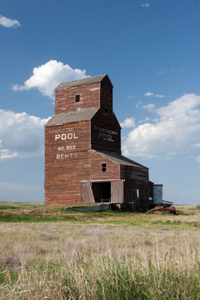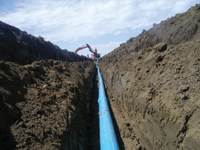
Regional water pipelines are putting water well drillers out of
business, says Canadian Ground Water Association (CGWA) first
vice-president and Ontario director Kevin Constable. He says water well
drilling business has dried up in a large chunk of Ontario.
Government-sponsored pipelines are a controversial solution creating unfair competition for well drillers.
Regional water pipelines are putting water well drillers out of business, says Canadian Ground Water Association (CGWA) first vice-president and Ontario director Kevin Constable. He says water well drilling business has dried up in a large chunk of Ontario.
“Almost all of southwestern Ontario is pipeline-fed and more and more pipelines are being installed all over southern Ontario. Based on some studies that were done in poorly constructed subdivisions with shallow wells and inadequate septic systems, it’s virtually impossible now to create new subdivisions with wells – they must be located next to a community and be served by municipal water and sewer services.”
 |
|
| Pipelines are hard to financially sustain in rural communities.
|
The issue is about more than the loss of business for water well drillers. There are many reasons water pipelines can be a poor solution when compared to the use of ground water. However, there are also many reasons pipelines receive strong government support.
“Water from pipelines is perceived as safer,” Constable explains. “It is also a seemingly ‘easy’ solution to the problem of water needs in areas with growing populations.” It’s also very much about esthetics.
“Ground water can look orange-ish and municipalities that use it have people calling all the time with concerns and complaints. Lake or river water is clearer, it’s soft – doesn’t contain iron – but just because it looks better doesn’t at all mean it’s safer. It could contain any number of pollutants, especially when it’s drawn from industrial areas. We’re putting a lot of faith in large water treatment plants to deliver safe water to enormous numbers of people.”
Dr. Bob Patrick, an assistant professor with the Department of Geography and Planning at the University of Saskatchewan, agrees that there are many issues surrounding the use of water pipelines. “Taking an inter-basin pipeline approach may only address the symptom of the problem and not the root cause of the problem,” he says.
To pipe or not to pipe?
Communities facing water quality or quantity issues may decide to transfer water from an adjacent jurisdiction to accommodate population growth, but this is not a sustainable approach.
“[It] may result in the town or city paying less attention to source protection, not restricting development, or not enacting land use restrictions to mitigate the original problems at hand.” This sort of temporary solution raises one big question for Patrick: “What happens if that source of transferred water, such as a Great Lake, becomes at risk from pollution, climate change, other development pressure?”
Another problem is the fact that surface water is not as reliable as ground water, says Alberta Water Well Drilling Association (AWWDA) director George McAllister. “In addition, it usually takes time to drain a pipeline, do the maintenance and refill the line – maybe two weeks.” There’s usually just two days’ worth of water in a typical pipeline reservoir. This raises the possibility of a serious water shortage during maintenance.
The pipelined community of Leduc, Alta., confronted this issue head on in April. Work on the lines forced the town to haul water in on tanker trucks after the reservoir ran dry.
 |
|
| The Alberta government sees how regional water lines can be cost effective in the long run.
|
Cost is another big concern. A little background: McAllister says about 10 pipelines have been installed in Alberta (mostly from rivers) over the last 20 years. Currently, there is a pipeline from Edmonton to Vegreville that the province wishes to extend from Vegreville to Lloydminster. Another one is planned from Vegreville north to the Saskatchewan border and these proposed pipelines are more than 340 kilometres combined. The upkeep on these pipelines linking distant communities could be problematic going forward.
“In terms of paying for the ongoing maintenance of the pipeline, there is a serious issue here because no money has ever been set aside for this and these areas are sparsely populated,” McAllister says. “We have already seen this scenario play out three or four times in the recent past, where the governments originally tried to pay for maintenance by charging only the people using it, but it wasn’t nearly enough money. Then they were going to charge everyone in the counties in the area of the pipeline whether they use pipelined water or not, but that was still not enough money.”
McAllister warns that in the case of these two new pipelines, there are even fewer people per square kilometre than in these other past cases. “Those who don’t use the water but have the pipeline crossing their property are charged a maintenance fee and you have no ability to refuse the pipeline, this yearly fee, or dispute how it may increase in the future. Everyone in the province will end up paying for these financially unsustainable projects.”
He adds that people in areas with pipelines are not allowed the choice to use a well or a pipeline – they have to use the pipeline.
If water pipelines are unsustainable in terms of the cost to Albertans, and if they put residents at greater risk from contamination and water quantity reliability, then why is the Alberta government proceeding with pipelines? The province sees it as job creation, says McAllister. “It also appears that the more pipelines there are, the more the government also gains control over water and is able to raise money from the use or the transportation of water.”
The AWWDA feels that the decision making process should be changed before more pipelines are given the go-ahead.
“We’ve talked to the county representatives in meetings and we’ve had meetings with the provincial government in the last few years and no one is listening,” says McAllister. “We are going to talk to a local MP in the near future and with the majority federal government, maybe we can make some headway.” He says it’s frustrating because no one at the local level is up to speed. “We go to speak to counsellors at the County of Vermilion River and they have no answers.”
AWWDA technical director and consulting hydrogeologist Ken Hugo explains that there are cases where pipelines make sense. But, he says, “Most of the impetus behind pipelines is from people who want to make money from pipelines. Pipeline companies say that aquifers are not sustainable and they also are at risk of contamination from oil field activity.”
In Hugo’s opinion, both claims are bogus.
“The government’s Groundwater Observation Network shows there’s no indication that aquifers are drying up. There have been cases of a little local contamination here and there, which happens, and some local cases where, for whatever reason – people pumping from their wells too much – aquifers have dried up temporarily, but aquifers are a sustainable resource.”
There are other concerns out there. Treating river or lake water to serve large numbers of people is quite expensive. Homeowners on water pipelines may have scarcity issues. For example, they may not be able to have a shower while running their dishwasher.
Hugo says the trouble is that pipelines are being automatically looked to as an answer to water woes. Instead, the need for a pipeline should have to be proven. In the last year, Hugo has attended a couple of presentations during which government personnel have discussed doing a “master development plan” to address land-use planning for the next 40 years. Hugo hopes that this planning will lead officials to take a closer look at water sustainability.
How the province sees it
Alberta has a long-term water management plan with three main goals: safe, secure drinking water; healthy aquatic ecosystems; and reliable, quality water supplies for a sustainable economy. The 2003 Water for Life plan sets out to achieve these goals through knowledge and research partnerships, and water conservation.
“Under the Water for Life strategy, Alberta Environment supports the use of regional water lines where they make sense to ensure a safe, secure water supply,” says Carrie Sancartier, a public affairs officer with Alberta Environment. “They are a cost-effective, long-term solution for small communities. That said, it is up to each community to decide the best way to supply their community with water.”
Once a community decides that a regional water line is the best way forward, a feasibility study is required. Funding for the regional water line and the feasibility study is available through the Alberta Municipal Water/Wastewater Partnership, which is administered through Alberta Transportation.
“Alberta’s role is to ensure that our laws are followed once a community decides the path forward, whether it’s a regional water line, surface water or ground water source,” says Sancartier. “This includes having the necessary authorizations in place. In any instance where an approval is required or amended under Alberta’s legislation, a 30-day public notification is required to allow those impacted to submit their concerns. In addition, the municipality may also have a mechanism in place to allow the public to provide input.”
When asked to respond to the concerns mentioned above about the costs of ongoing pipeline maintenance being unsustainable, Sancartier says, “In the long term [decades], a regional water line can be cost effective compared to numerous single operators [municipalities] that would have to cover their own water infrastructure and program costs. That said, it would depend on variables that are specific to a line, such as how many municipalities are connected, the distance between them, etc. That’s why a feasibility study is so important to the process. At the end of the day, it is up to the municipality to decide based in its own unique circumstances.”
The pipeline problem isn’t a new one for the industry. Wayne MacRae, CGWA executive director, says water pipelines are an issue that has come up off and on over the past 10 years or so. As the pipelines extend their reach, the association is wrestling with the best way to respond.
“We’re going to talk about it at the next full board meeting to try and find out what’s happening across the country,” he says. Directors from each province will provide thumbnail sketches of the issues in their jurisdictions.
Stay tuned!
Treena Hein is a science writer based in Ontario.
Print this page